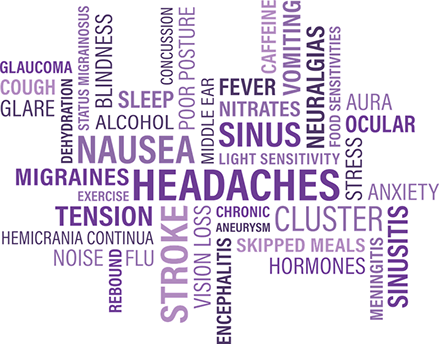What is a Headache?
A headache is defined as a pain arising from the head or upper neck of the body. The pain originates from the tissues and structures that surround the skull or the brain because the brain itself has no nerves that give rise to the sensation of pain (pain fibers). The thin layer of tissue (periosteum) that surrounds bones, muscles that encase the skull, sinuses, eyes, and ears, as well as thin tissues that cover the surface of the brain and spinal cord (meninges), arteries, veins, and nerves, all can become inflamed or irritated and cause headache. The pain may be a dull ache, sharp, throbbing, constant, intermittent, mild, or intense.
Primary Headaches
A primary headache is caused by over-activity of or problems with pain-sensitive structures in your head. A primary headache isn’t a symptom of an underlying disease.
Chemical activity in your brain, the nerves or blood vessels surrounding your skull, or the muscles of your head and neck (or some combination of these factors) can play a role in primary headaches. Some people may also carry genes that make them more likely to develop such headaches.
The most common primary headaches are:
- A cluster headache
- A migraine (with and without aura)
- A tension headache (also known as a tension-type headache)
- Trigeminal autonomic cephalalgias (TAC), such as a cluster headache and paroxysmal hemicrania

A few headache patterns also are generally considered types of a primary headache but are less common. These headaches have distinct features, such as an unusual duration or pain associated with a certain activity.
Headaches may be caused by other problems elsewhere in the head or neck. For example cervicogenic headache (pain arising from the neck muscles). Medication overuse headache may occur in those using excessive painkillers for headaches, paradoxically causing worsening headaches. A number of characteristics make it more likely that a headache is due to potentially dangerous secondary causes; some of these may be life-threatening or cause long-term damage. A number of “red flag” symptoms, therefore, means that a headache warrants further investigations, usually by a specialist. The red flag symptoms are a new or a different headache in someone over 50 years old, headache that develops within minutes (a thunderclap headache), inability to move a limb or abnormalities on neurological examination, mental confusion, being woken by a headache, headache that worsens with changing posture, a headache worsened by exertion, visual loss or visual abnormalities, neck stiffness, fever, and headaches in people with HIV, cancer or risk factors for thrombosis. Headaches are most likely to be primary (non-serious and self-limiting), some specific secondary headache syndromes may demand specific treatment or may be warning signals of more serious disorders. Differentiating between primary and secondary headaches can be difficult.
As it is often difficult for patients to recall the precise details regarding each a headache, it is often used for the sufferer to fill-out a “headache diary” detailing the characteristics of a headache. When a headache does not clearly fit into one of the recognized primary headache syndromes or when atypical symptoms or signs are present then further investigations are justified and neuroimaging [CT/MRI] is generally recommended. One type of treatment, however, is usually not sufficient for chronic sufferers and they may have to find a variety of different ways of managing, living with, and seeking treatment of chronic daily headache pains.
There are however two types of treatment for chronic headaches, i.e. acute abortive treatment and preventive treatment. Whereas the first is aimed to relieve the symptoms immediately, the latter is focused on controlling the headaches that are chronic. The primary goal of preventive treatment is to reduce the frequency, severity, and duration of headaches. This type of treatment involves taking medication on a daily basis for at least 3 months and in some cases, for over 6 months.

Secondary headaches are:
- Brain tumor.
- Head injury.
- Stroke.
- Infections of the brain or its coverings.
- High blood pressure.
- Giant cell arteritis.
- Diseases of eye / ear / tooth / tempera mandibular joint.
- Medications



